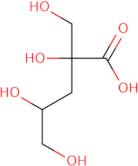
Informations sur le produit
- a-D-Isosaccharinic acid
- (2S,4S)-2,4,5-Trihydroxy-2-(hydroxymethyl)pentanoic acid
- 3-Deoxy-2-C-(hydroxymethyl)-<span class="text-smallcaps">D</span>-erythro-pentonic acid
- <span class="text-smallcaps">D</span>-erythro-Pentonic acid, 3-deoxy-2-C-(hydroxymethyl)-
- <span class="text-smallcaps">D</span>-gluco-Isosaccharinic acid
- pentonic acid, 3-deoxy-2-C-(hydroxymethyl)-
- α-<span class="text-smallcaps">D</span>-Glucoisosaccharinic acid
- α-<span class="text-smallcaps">D</span>-Isosaccharinic acid
- α-Glucoisosaccharinic acid
- α-Isosaccharinic acid
- Voir d'autres synonymes
- α-D-Isosaccharinic acid
- D-gluco-Isosaccharinic acid
- 3-Deoxy-2-C-(hydroxymethyl)-D-erythro-pentonic acid
- D-erythro-Pentonic acid, 3-deoxy-2-C-(hydroxymethyl)-
- α-D-Glucoisosaccharinic acid
Isosaccharinic acid is a bacterial strain that produces isosaccharinic acid as its main fatty acid. The thermodynamic data for the reaction mechanism of the conversion of glucose to isosaccharinic acid has been determined. Isosaccharinic acid formation is catalyzed by an enzyme called glycosyl-glycerate dehydrogenase, which converts glycerate to 3-hydroxypropanoic acid and then to 3-oxopropanoate before it undergoes decarboxylation and reduction to form isosaccharinic acid. Radionuclides such as TcO4 are used in chemical ionization mass spectrometry for the detection of this compound in samples. Neutral pH, high activation energies, and low binding constants are all factors that affect the stability of this molecule.
Propriétés chimiques
Question d’ordre technique sur : 3D-MI08218 Isosaccharinic acid
Si vous souhaitez demander un devis ou passer commande, veuillez plutôt ajouter les produits souhaités à votre panier, puis demander un devis ou passer commande à partir de votre panier. C'est une méthode plus rapide, plus économique, et vous pourrez bénéficier des remises disponibles ainsi que d'autres avantages





